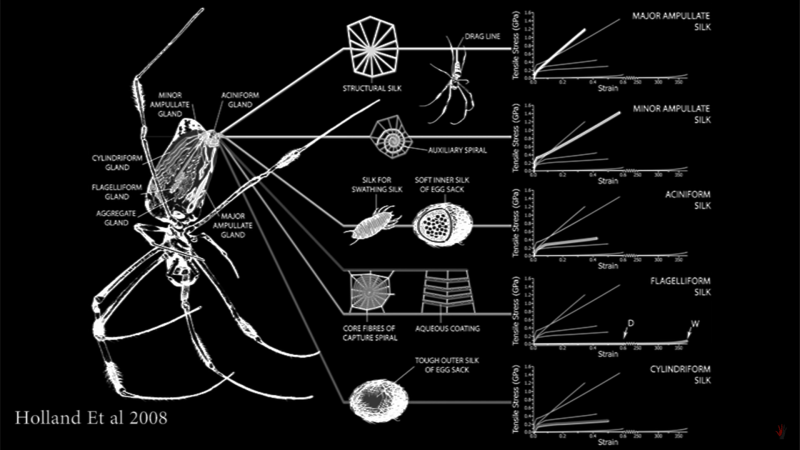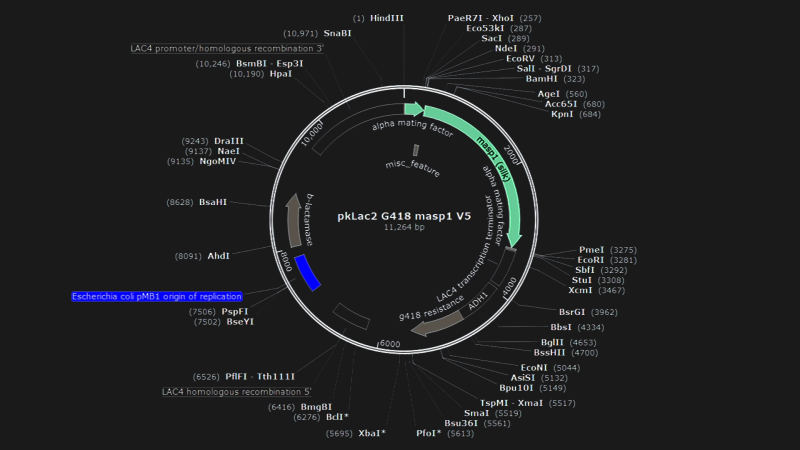Many people who read Hackaday hold the title of “Webmaster” but [The Thought Emporium] is after slightly different credentials with the same title. He aims to modify a strain of yeast to produce spider silk. Charlotte’s Web didn’t go into great detail about the different types of silk that a spider can produce, but the video and screencap after the break give a rundown of how spiders make different types of silk, and that each species of spider makes a unique silk. For this experiment, the desired silk is “beta sheets” which the video explains are hard and strong.
Some of the points mentioned in the video rely on things previously mentioned in other videos, but if you are the type of person excited by genetic modifications or using modified yeast to produce something made by another lifeform, you will probably be just fine. This is one of the most technical videos made by [The Thought Emporium] as he goes into the mechanisms of the modifications he will be making to the yeast. It sounds like a lot of work and the financial benefit of being able to produce spider silk affordably could be great, but in true hacker form, the procedure and results will be made freely available.
For some background into this hacker’s mind, check out how he has hacked his own lactose intolerance and even produced graphene through electrochemical exfoliation.

An update on youtube.















This bring “Getting drunk on success” to a whole ‘nother level… Awesome!
Heyo!
Fantastic project. i am looking forward to this.
From what I’ve read previously there have been plenty of spider silk proteins produced by gene spliced bacteria, yeast, etc. in the past few years but nobody has yet figured out how to duplicate the microscopic mechanical action of the spinner organ of the spider which turns out to be important to making strong silk… This is the first step but there’s still a way to go to spin it correctly once it’s been synthesized.
Maybe that’ll be the next puzzle in Opus Magnum?
Yes exactly this. IAABiochemist. Cloning these genes into yeast or E coli is trivial and has been done already, Edlund et al., Nat biotech 2018 PMID 29277712 (E coli) and Jansson et al., Biotech J 2016 PMID 26814048 (Pichia yeast) and Heidebrecht et al., has a review on most cloned spider silks (AAMicro 2013) PMID 23415154. Producing all of the proteins and combining them in a spinnerette (The spinning part) is the most challenging by far. The two most mature uses of the technology are cloned spider silk in goat-milk, where it can be spun industrially into a spider silk that is better than bad, but not as good as nature, and cloned spider silk into silkworms. This one has great promise because we already have the husbandry worked out for silkworms, they already produce silk, so spinning is largely ‘solved’ and you are in simple terms substituting spider silks for the native silk the worm used for its cocoon.
Some other molecular comments that will only appeal to experts. 1.) The vector described doesn’t work in S. cerevisiae (Bakers yeast) It is a vector for a completely different strain of yeast (K. lactis) with some E coli stuff thrown in for shuttling. 2.) Using restriction digestion to produce these cloned strains is a bit dated in how this would be approached with any modern cloning method. 3.) Spider DNA (or most any eukaryotic DNA) can’t be directly cloned from as the DNA isn’t an exact copy of the protein that is produced. You will need to extract spider mRNA, RT it to cDNA, and then you can clone from that.
I can confirm what Matt says.
I was an early investor in the company that makes spider silk proteins in goats milk (trans-genic goats, aka “spider goats”). The process held a lot of promise, but didn’t work out.
Apparently there is some physical process in the spinnerette that combines the proteins in a way that makes strong spider silk. All attempts to date have failed to reproduce that process, with the result that we can produce the base components, but not the actual silk.
Spinning spider silk is a hard process that’s been looked at by lots of top-tier people, so I don’t hold a lot of hope that a non-professional can solve it.
If you want to try an unexplored approach, perhaps electrospinning could substitute for a spinnerette, using electric charge to modify and combine the proteins.
https://hackaday.io/project/10599-electrospinning-machine
Does this mean that Spiderman will be more like a St Bernard with a barrel around his neck?
No, he’ll just be able to pee beer.
Go look at his older videos. He engineered a virus and treated himself with it to permanently cure his lactose intolerance.
Yes with actual science to back it up and research into double blind populations… oh wait.
Isn’t spider silk, also spider poop? The strength might not be from the spinning, but more of a two-part process. The bulk is produced in the bowels/silk glands, but another enzyme/protein is mixed in on excretion from the body.
Sort of scary, thinking about how pretty much anyone with the equipment can modify organisms as they please, to do what they want, without much stopping them. It’s cool about curing his lactose intolerance, and lots of people would appreciate getting infected with the virus. Lactose, and a lot of strong allergens are hidden in foods. We had a father in Florida, who wanted his daughter to have the public school experience, and a real graduation. His daughter had a severe peanut allergy. Dad was able to get the whole school peanut product clean, banned anything peanut related, even had peanut sniffing dogs, sack-lunch checks, for that on year, because she was entitled, because the condition is considered a handicap. I’m all for reasonable accomodations in most cases, but this was plain selfish, and still a little risky. The scary part, is the Dr. Jekyll and Mr. Hyde aspect, using the lab, for personal experiments, specially for tiny things that might get loose, or intentionally released. Vast majority of people use the tools they have access to responsibly, and as intended. Unfortunately, just a few, use those tools, to harm people, complete strangers, no justification.
“Isn’t spider silk, also spider poop?”
No.
I think the spiders might be tricking us into creating our own silk and wrapping ourselves in it.
Oh. My. Gosh. They’re playing the slow game and they’ve set the deadliest trap in motion thousands of years ago. Diabolical.
Another moron tier article. He hasn’t done shit yet, more importantly most fiber derive strength from anisotropy, if you don’t know what that word is you have no business writing this article. Do you know what a spinneret is? Please just mix all your crap articles with bleach blend them for 40 minutes and drink them.
Hey friend, would you like to have a discussion about this article in private?
brianmcevoy@hackaday.com
Out of all the technologies in the world, biohacking is the only one that really scares me as an viable world-ending scenario. The kit to be able to modify viruses to target human DNA is already within the scope of a reasonably affluent enthusiast and dropping all the time. It’s not going to be long before people are hacking stuff they shouldn’t and it gets out in to the wild to spread.
Research money is tight, the profitable science is Climatology and going ‘green’. Wonder what happens to the labs, equipment, and scientists, who have to shut down, do to budget cuts, or no further funding? Most will find new projects, and funding, but a few will want to finish what they started, or use what they learned for other things. Equipment becomes outdated quickly, and pretty much useless to a newly funded projects. Some will still find new homes, still useful on the cheap. Reality is, a whole lot of expensive equipment is basically thrown in the dumpster, who knows where it goes from there.
The stuff that we get to read about is scary, but what of the classified research? What are other countries using the same technology to gene hack organisms? Nuclear and chemical weapons of mass destruction draw a lot of attention and sanctions. Biologicals aren’t quite as obvious, not as simple to detect, and would take a while to stop, once released. Suppose someone were to modify stinging/biting insects to be lethal, instead of unpleasant?
What about the self-taught scientist, who patches together the bare minimal equipment needed to play around. Will he dispose of his failed experiments responsibly, or just flush them down the toilet? Throw his protective gear, like gloves, in the household trash?
Research funding for biology and medicine has been going up steadily. Funding is tight because there are a ton of biologists and even more interesting problems to investigate.
Creating new things is very hard; it is almost always impossible for biologists today. Biologists are mainly swapping out and recombining things that already exist in different organisms. The tools biologists use work best in the half dozen lab grown organisms that have been used for decades (particular strains of E. coli, yeast, nematodes, fruit flies, mice and rats) with which biologists have hundreds of thousands of person-hours of experience. These organisms no longer can compete in the wild. Getting a version of the standard genetic engineering tools to work in a new organism is often difficult and can take years.
Creating new dangerous organisms is very difficult. The most dangerous virus is not the most deadly one, it is one right on the knife edge of properties that allow it to spread between hosts, infect, reproduce, and harm. Tweak any one quality of a virus and all the others change unpredictably.
The trash from a hospital is much more dangerous than a university biology department. Lots of infectious human pathogens, and people walking in and out every day. The waste from a farm is similarly rich in infectious agents. Similar, though to a lesser extent, your house. Mostly, sterile technique in biology labs is to keep the outside from eating the experiment, not to keep things in.
Two thoughts:
1. Now I know how my non-computer friends hear me when I speak of Network Security.
2. Does anyone else think that maybe it’s not a good idea to cross genes in a home lab with a strain of yeast and a poisonous spider from North America– then try to brew beer with it?